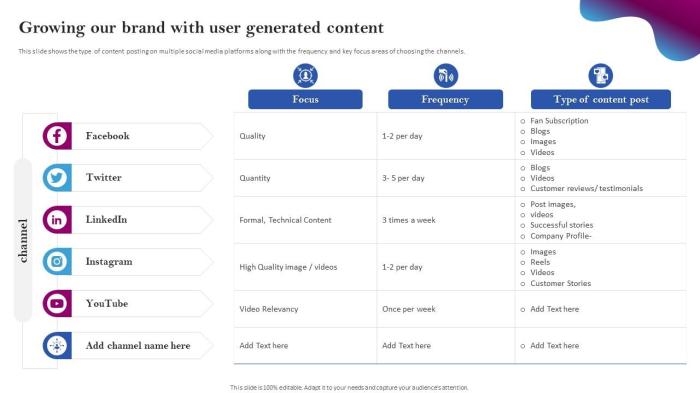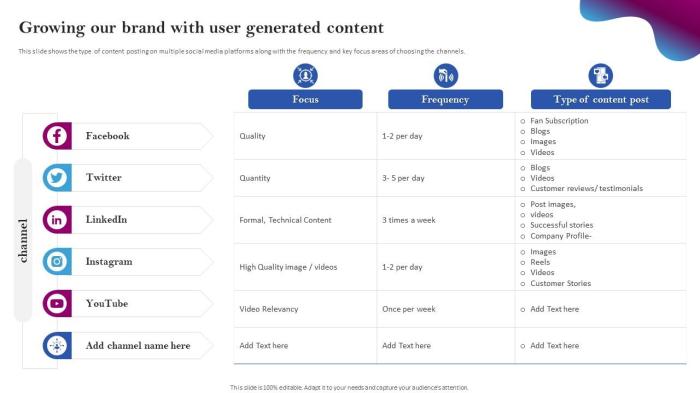Utilizing microcontent for branding and social media efforts is crucial in today’s fast-paced digital landscape. This approach allows brands to connect with audiences on a deeper level, fostering engagement and building stronger brand recognition through impactful short-form content. From captivating short videos to engaging images and GIFs, we’ll explore how microcontent can revolutionize your social media strategy, boosting brand awareness and driving measurable results.
We’ll delve into the specifics of defining microcontent, examining its diverse formats, and analyzing effective strategies for integrating it seamlessly into existing social media plans. Learn how to create captivating microcontent, measure its impact, and even analyze successful case studies from brands who have leveraged this approach to achieve exceptional results. We’ll also address potential challenges and discuss future trends in microcontent creation and usage.
Defining Microcontent for Branding
Microcontent, in the context of branding, refers to concise and easily digestible pieces of information designed to capture attention and communicate key brand messages efficiently across various digital platforms. Unlike lengthy articles or in-depth reports, microcontent leverages brevity and visual appeal to maximize engagement and brand recall. Its adaptability makes it ideal for social media and other online channels, where users often have limited time and attention spans.Microcontent excels by presenting information in a readily consumable format, maximizing its impact in the fast-paced digital landscape.
This approach stands in contrast to traditional content formats, which often demand more time and effort from the audience to fully appreciate.
Characteristics of Microcontent
Microcontent distinguishes itself from traditional content formats by its inherent brevity, visual focus, and immediate engagement. It’s designed for quick consumption and immediate action, fostering a sense of immediacy that traditional content formats often lack. The key characteristics that differentiate microcontent include:
- Brevity: Microcontent is intentionally short, making it easily scannable and quickly digestible. This is particularly important in a world where attention spans are shrinking.
- Visual Emphasis: Visual elements such as images, GIFs, and videos are frequently incorporated to enhance engagement and understanding. This approach complements the brevity of the content and makes it more memorable.
- Action-Oriented: Microcontent often encourages specific actions, like visiting a website, following a social media account, or making a purchase. This focus on call-to-action is a key differentiator.
Types of Microcontent
Microcontent comes in various forms, each with its own strengths and weaknesses for brand building. The versatility of these formats allows brands to tailor their messaging to different platforms and target audiences.
- Short-Form Videos: These videos, typically lasting under a minute, are highly engaging and effective for conveying information quickly. They can be used to showcase products, explain concepts, or highlight brand values.
- Images: High-quality images can instantly communicate brand aesthetics and convey a specific message. Images can be used to highlight products, showcase events, or express brand personality.
- GIFs: Animated GIFs are excellent for capturing attention and conveying emotion. They can be used to illustrate concepts, showcase brand humor, or add a touch of personality to social media posts.
- Quotes: Quotes, often paired with an image, can express brand values, convey a message of inspiration, or showcase expert opinions. Quotes are a succinct and impactful way to communicate.
Strengths and Weaknesses of Microcontent Formats
The table below Artikels the strengths and weaknesses of different microcontent formats for brand building. This table will help marketers determine which formats are best suited for their specific goals.
Short, impactful content is key for grabbing attention on social media. Using microcontent for branding and social media efforts is a great way to build a strong online presence. Sometimes, though, even the best microcontent strategies can feel daunting. Fortunately, a good booklist on overcoming fears, like the one available here , can help you build confidence and conquer those hurdles.
Ultimately, mastering microcontent for branding and social media is about understanding your audience and creating engaging content that resonates with them.
| Format | Strengths | Weaknesses |
|---|---|---|
| Short-Form Videos | Highly engaging, versatile for conveying information and emotions, great for product demos. | Production costs can be higher, requires some technical expertise, may not be suitable for all platforms. |
| Images | Visually appealing, quickly conveys messages, broad appeal. | Limited in conveying complex information, requires high-quality visuals, may not be suitable for all platforms. |
| GIFs | Highly engaging, convey emotion, perfect for humor and personality. | May not be suitable for all audiences, can be perceived as overly casual. |
| Quotes | Concise and impactful, communicate brand values and expert opinions. | Limited in conveying detailed information, may not be suitable for complex topics. |
Strategies for Integrating Microcontent

Microcontent, in its concise and engaging nature, presents a powerful tool for brands to connect with audiences on social media. It allows for quick consumption, instant engagement, and effective brand building. By strategically incorporating microcontent into existing social media strategies, brands can maximize their reach and impact. This approach allows for a more dynamic and interactive experience for users.Integrating microcontent seamlessly into a brand’s social media presence is crucial for fostering a strong connection with the target audience.
This approach not only enhances engagement but also creates a more cohesive and memorable brand identity. It’s about understanding the nuances of different platforms and tailoring microcontent formats to maximize their impact.
Effective Strategies for Social Media Integration
Integrating microcontent into existing social media strategies requires careful planning and execution. It’s about choosing the right format, platform, and timing. The goal is to seamlessly blend microcontent into the existing flow of posts, rather than disrupting it. This will increase user engagement and brand awareness.
- Leveraging Different Formats: Varying the format of microcontent is essential. This could include short-form videos, engaging GIFs, captivating images, insightful quotes, or thought-provoking questions. Employing a mix of formats ensures diverse appeal and caters to various user preferences.
- Crafting Compelling Headlines: A well-crafted headline is paramount to capturing attention and driving engagement. Microcontent headlines should be concise, informative, and relevant to the target audience. Use s and compelling language to increase click-through rates.
- Utilizing Trending Topics: Aligning microcontent with trending topics allows brands to tap into current conversations and maintain relevance. This is vital for enhancing brand visibility and fostering engagement.
- Optimizing for Platform-Specific Characteristics: Each social media platform has its own nuances and user behaviors. For instance, Instagram excels with visually-driven content, while Twitter thrives on quick, concise messages. Understanding these nuances is critical for crafting effective microcontent.
Storytelling and Engagement Through Microcontent
Microcontent is exceptionally well-suited for storytelling. Its brevity and dynamic nature allow brands to deliver concise narratives, highlighting key aspects of a story in a compelling and memorable way. This encourages audience interaction and fosters a sense of community.
- Building a Narrative: By using microcontent, brands can weave a continuous narrative across multiple posts. This allows for a more comprehensive and engaging brand story, leading to greater audience connection.
- Encouraging Interaction: Microcontent, especially in the form of questions or polls, encourages audience interaction. This fosters a sense of community and makes the brand feel more approachable.
- Creating a Consistent Brand Voice: Maintaining a consistent brand voice across all microcontent pieces is vital. This creates a recognizable and memorable brand identity, building trust and recognition among followers.
Building Brand Awareness and Recognition
Microcontent is a powerful tool for increasing brand awareness and recognition. Its concise and engaging nature makes it ideal for sharing key information and brand messages, driving more engagement and visibility.
- Creating Brand Recall: Regularly using microcontent with consistent branding elements aids in creating a strong brand recall. This reinforces brand recognition and memorability among audiences.
- Highlighting Key Brand Messages: Microcontent provides an effective way to highlight key brand messages in a succinct and easily digestible format. This ensures that brand values and messaging remain front of mind.
- Increasing Brand Visibility: Microcontent’s ease of sharing and distribution on social media platforms helps increase brand visibility. This allows brands to reach a wider audience and engage with potential customers.
Comparison of Microcontent Strategies Across Platforms
The effectiveness of microcontent strategies varies across different social media platforms. The key is to tailor content to the platform’s unique features and user behavior.
| Platform | Microcontent Strategy | Example |
|---|---|---|
| Visually-driven content, short videos, engaging images | A visually appealing photo with a brief caption highlighting a new product or promotion. | |
| TikTok | Short-form video content, trending challenges, music integration | A short video showcasing a product in action set to trending music. |
| Concise messages, trending hashtags, quick updates | A tweet summarizing a company announcement or responding to a trending topic. |
Creating Engaging Microcontent
Microcontent, with its concise and easily digestible nature, is a powerful tool for branding and social media. Its effectiveness lies not only in its brevity but also in its ability to resonate with audiences on a deeper level. This section delves into strategies for crafting compelling microcontent, focusing on visual appeal, brand consistency, and user interaction. We’ll explore different formats, and offer practical tips for optimizing engagement.Crafting microcontent that truly captures attention requires understanding your target audience and tailoring the message accordingly.
Effective microcontent often leverages a variety of formats, ensuring variety and maintaining audience interest.
Short, snappy microcontent is key for grabbing attention on social media. Think bite-sized travel tips, like packing light for your next adventure. Mastering the art of travel with just hand luggage, as detailed in this helpful guide how travel with just hand luggage , is a great way to keep your brand focused and visually engaging. It’s all about efficient communication and captivating visuals for a successful branding strategy.
Compelling Microcontent Formats
Different formats cater to various communication styles and preferences. Short-form video, engaging GIFs, eye-catching images, and concise text-based posts all have their place in a comprehensive microcontent strategy. Using a mix of formats keeps the content fresh and interesting. For example, a short video can demonstrate a product feature, while an infographic can illustrate complex data.
Crafting Resonant Microcontent
Understanding your audience is crucial. Microcontent should speak directly to their needs, interests, and pain points. For example, if your target audience is busy professionals, short, actionable tips or quick tutorials will likely resonate more than lengthy articles. Focus on offering value, answering questions, and sparking curiosity. Use language that is clear, concise, and relatable.
Visual Appeal and Digestibility, Utilizing microcontent for branding and social media efforts
Visual elements are key to microcontent success. High-quality images and videos are essential, as well as consistent branding elements. Ensure your visuals are clear, high-resolution, and relevant to the message. Think about using colors and typography that align with your brand identity. For instance, using a vibrant color palette for a youth-focused brand conveys energy and excitement.
Maintaining Brand Consistency
Brand consistency is paramount. Your microcontent should reflect your brand voice and visual identity. Maintain a consistent tone of voice, use your brand colors and fonts consistently, and ensure your message aligns with your overall brand strategy. This helps build recognition and trust. Example: A humorous brand voice should be evident in all microcontent.
Successful Audience Engagement Examples
A successful example of microcontent is a series of short videos demonstrating product usage. This visual format is easily digestible and demonstrates value directly. Another successful example is a series of engaging GIFs showcasing the humor and personality of a brand. The key is to offer a value proposition to the audience, and not simply self-promotion.
Driving User Interaction
Microcontent should encourage interaction. Use calls to action, ask questions, and create opportunities for comments and shares. For example, asking a question in a caption or posing a poll encourages interaction.
Best Practices for Captivating Captions and Descriptions
| Element | Description | Example |
|---|---|---|
| Headline | Compelling and concise, highlighting the key takeaway. | “Effortless Skincare Routine” |
| Body Copy | Supporting details, value proposition, and calls to action. | “Discover our 3-step routine for glowing skin. Link in bio for the full guide!” |
| Hashtags | Relevant and trending hashtags to expand reach. | #skincare #glowingskin #beautytips |
| Brand Voice | Consistent with overall brand identity. | Friendly and informative tone for a beauty brand. |
| Call to Action | Clear and concise action for the audience. | “Shop now! Link in bio.” |
Following these best practices for captions and descriptions helps optimize microcontent engagement. Consistent, high-quality content increases visibility and establishes brand authority.
Measuring the Impact of Microcontent
Understanding the effectiveness of microcontent strategies is crucial for optimizing brand perception and achieving marketing goals. Quantifiable metrics allow brands to track progress, identify areas for improvement, and ultimately demonstrate the return on investment (ROI) of these concise communication tools. This section dives into methods for measuring microcontent’s impact, focusing on brand perception enhancement and tangible results.Measuring the effectiveness of microcontent goes beyond simple engagement counts.
It requires a holistic approach, considering how these brief pieces contribute to the overall brand narrative and resonate with the target audience. This includes evaluating the impact on brand sentiment, analyzing engagement rates across various formats, and calculating the ROI of microcontent campaigns.
Assessing Microcontent Performance
Understanding microcontent performance requires establishing clear brand goals and aligning metrics with those objectives. A successful strategy needs to be measured against these goals. For example, if a goal is to increase brand awareness, metrics should focus on reach and impressions. If the objective is lead generation, then metrics should include click-through rates and conversion rates.
Metrics for Evaluating Microcontent
A comprehensive approach to measuring microcontent success involves monitoring a range of metrics. These metrics offer insights into how well microcontent resonates with the audience and supports brand objectives. Crucially, the metrics should be tailored to the specific goals of the microcontent campaign.
- Reach and Impressions: Tracking the number of unique users exposed to the microcontent provides insights into its potential impact. This can be measured across various platforms. High reach indicates a wider audience exposure, while high impressions highlight the frequency of exposure.
- Engagement Metrics: Analyzing metrics such as likes, shares, comments, and retweets offers insights into the level of audience interaction and interest. Increased engagement suggests the content is well-received and encourages further interaction.
- Click-Through Rates (CTR): For microcontent designed to drive traffic to a website or landing page, monitoring the CTR is essential. A higher CTR indicates that the microcontent is effectively capturing the audience’s attention and motivating them to take the desired action.
- Conversion Rates: If the microcontent is intended to generate leads or conversions, tracking the conversion rate is crucial. A high conversion rate signifies that the microcontent is effectively persuading the audience to take the desired action.
Tracking and Analyzing Microcontent Engagement Metrics
Effective tracking and analysis of microcontent engagement involve utilizing analytics tools offered by social media platforms and website analytics platforms. Tools allow for comprehensive data collection and reporting.
- Social Media Analytics: Platforms like Facebook Insights, Twitter Analytics, and Instagram Insights provide detailed data on reach, engagement, and demographics of users interacting with microcontent. This data can be used to identify trends and tailor future microcontent to better resonate with the audience.
- Website Analytics: Tools like Google Analytics can track website traffic driven by microcontent links. This data helps measure the effectiveness of microcontent in driving users to the website, and can be used to refine the microcontent to maximize website traffic.
- Custom Dashboards: Combining data from various sources into a single dashboard offers a consolidated view of microcontent performance. This allows for a comprehensive understanding of the effectiveness of microcontent across different platforms.
Evaluating the ROI of Microcontent Investments
Quantifying the ROI of microcontent requires a clear understanding of the initial investment and the resulting benefits. This should be directly linked to the specific goals and objectives of the microcontent strategy.
- Cost per Acquisition (CPA): By dividing the cost of the microcontent campaign by the number of conversions generated, the CPA can be calculated. This metric helps assess the cost-effectiveness of the microcontent in driving conversions.
- Attribution Modeling: Identifying the microcontent that contributes most significantly to conversions is vital for calculating ROI. This process helps identify the specific pieces of microcontent that are driving the most value.
- Benchmarking: Comparing microcontent performance against industry benchmarks helps assess whether the strategy is meeting or exceeding expectations.
Assessing the Impact of Microcontent on Brand Sentiment
Monitoring brand sentiment in response to microcontent provides insights into the overall perception of the brand. This involves analyzing feedback, reviews, and social media discussions related to the microcontent.
- Sentiment Analysis Tools: These tools automatically analyze social media posts and comments to determine the overall sentiment expressed towards the brand and the microcontent. This can help identify trends and patterns.
- Social Listening: Actively monitoring conversations and discussions about the brand on social media platforms helps gauge public sentiment and identify potential issues.
Comparing Engagement Rates Across Microcontent Formats
Analyzing engagement rates across different microcontent formats (e.g., videos, images, text posts) provides insights into which formats resonate most strongly with the target audience.
- Format-Specific Analysis: Comparing the engagement metrics for different microcontent formats allows for a deeper understanding of what resonates most with the target audience. This includes evaluating the engagement levels across different platforms.
- A/B Testing: Testing different microcontent formats with similar audiences helps determine which formats yield the highest engagement rates. This can be used to optimize future campaigns.
Case Studies and Examples
Microcontent, with its brevity and targeted delivery, is proving to be a powerful tool for brands seeking to engage audiences on social media. Understanding how successful brands are leveraging microcontent offers valuable insights into maximizing its impact. These case studies showcase the strategies employed and the measurable results achieved, providing a blueprint for effective microcontent campaigns.Successful microcontent campaigns aren’t just about posting short snippets; they’re about crafting engaging experiences that resonate with the target audience.
By examining real-world examples, we can identify key strategies and best practices to drive brand awareness and engagement. These examples demonstrate how brands can use microcontent to connect with audiences on a deeper level, fostering brand loyalty and ultimately driving business results.
Successful Brand Applications of Microcontent
Microcontent campaigns are proving effective for various brands across different industries. Brands are utilizing different approaches to achieve their goals, showcasing the adaptability of this strategy. Analyzing these examples highlights the diverse ways microcontent can be integrated into a broader marketing strategy.
Example: Nike’s Use of Short-Form Video
Nike, a global sportswear brand, has effectively used short-form video content on platforms like TikTok and Instagram Reels. They feature athletes showcasing quick workout routines, behind-the-scenes glimpses into training, or motivational messages. These concise videos, often accompanied by trending audio and engaging visuals, have proven highly effective in reaching a younger demographic and reinforcing Nike’s brand image as a leader in athletic performance.
Using microcontent for branding and social media is crucial. But, sometimes we unintentionally stifle our own creativity and curiosity, hindering our brand’s potential. Learning how to overcome this, as explored in this insightful article on how kill our innate curiosity and how stop doing that , is vital. Ultimately, harnessing that curiosity and applying it to microcontent strategies will unlock more engaging and effective brand campaigns.
The results demonstrate a significant increase in brand mentions and engagement metrics, indicating that microcontent can be a powerful tool for reaching new audiences and reinforcing brand identity.
Example: Starbucks’ Use of Interactive Polls and Quizzes
Starbucks leverages interactive content like polls and quizzes on Instagram Stories and Facebook to engage its audience. These micro-interactions encourage user participation and gather valuable insights into customer preferences. For example, a quiz asking users about their favorite coffee flavor generates user-generated content, builds community, and provides data to refine product offerings. These campaigns result in higher user engagement rates, increased brand awareness, and better understanding of customer preferences.
Example: ASOS’ Use of Lifestyle-Focused Micro-Blog Posts
ASOS, an online fashion retailer, uses concise blog posts on platforms like Pinterest and Instagram to share styling tips, fashion trends, and behind-the-scenes looks. These short, visually-driven posts allow the brand to reach a wider audience while keeping the content concise and easily digestible. The result is a boost in website traffic, increased brand visibility, and a strong connection with its fashion-conscious audience.
The microcontent provides a constant flow of fresh, engaging content for the target audience.
Table: Microcontent Campaign Examples
| Brand | Strategy | Platform | Results |
|---|---|---|---|
| Nike | Short-form videos showcasing athletic performance and motivation | TikTok, Instagram Reels | Increased brand mentions, high engagement rates, reaching a younger demographic |
| Starbucks | Interactive polls and quizzes on customer preferences | Instagram Stories, Facebook | Higher user engagement, increased brand awareness, better understanding of customer preferences |
| ASOS | Lifestyle-focused micro-blog posts on styling tips and fashion trends | Pinterest, Instagram | Increased website traffic, brand visibility, strong connection with fashion-conscious audience |
Future Trends in Microcontent
Microcontent, with its brevity and immediacy, is rapidly transforming how brands interact with audiences across social media and beyond. As technology advances and consumer expectations evolve, microcontent is poised for even greater innovation. The future of microcontent will involve a shift from simple text updates to interactive experiences and personalized interactions.The evolution of microcontent will be driven by the increasing need for brands to connect with audiences in meaningful and engaging ways.
This means moving beyond basic text updates to more dynamic and interactive formats that encourage audience participation and build stronger brand relationships.
Emerging Trends in Microcontent Creation
Microcontent creation is becoming increasingly sophisticated, driven by the need for more personalized and engaging content. Expect to see a rise in AI-powered tools that can generate various microcontent formats tailored to specific audience segments. Brands will leverage these tools to craft customized messages, boosting engagement and relevance.
Future Formats for Microcontent
The future of microcontent is diverse and adaptable. Expect to see a wider range of formats beyond the traditional text and image. Video snippets, interactive polls, augmented reality experiences, and personalized quizzes will become more prevalent. These formats allow for deeper engagement and richer brand storytelling.
Role of AI in Microcontent Optimization
AI is poised to play a significant role in optimizing microcontent for maximum impact. AI algorithms can analyze audience data to understand preferences and tailor microcontent accordingly. This personalized approach allows for more relevant messaging, maximizing engagement and return on investment. For example, AI can identify trending topics and tailor microcontent to align with current conversations, improving reach and resonance.
Influence of New Technologies and Platforms
New technologies and platforms are significantly impacting microcontent strategies. The rise of the metaverse, for instance, will likely introduce new microcontent opportunities, such as immersive brand experiences. Similarly, the increasing adoption of virtual and augmented reality technologies will provide opportunities for interactive microcontent experiences. Brands will need to adapt their strategies to these emerging platforms to stay relevant.
Adapting to Future Microcontent Trends
Brands can adapt to these future trends by focusing on personalization and interactivity. Investing in AI-powered tools to analyze audience data and generate customized content will be crucial. Experimenting with new formats, such as interactive videos and augmented reality experiences, will be vital to maintaining engagement. Furthermore, brands should proactively monitor the evolution of new platforms and technologies, seeking opportunities to leverage them for microcontent strategies.
Addressing Potential Challenges
Microcontent, while powerful for engagement, presents unique hurdles in branding and social media. Successfully navigating these challenges is crucial for achieving desired brand outcomes. Strategies to overcome these obstacles and leverage microcontent effectively are essential for a positive return on investment.Effective microcontent strategies require careful planning and execution to ensure alignment with overall brand objectives. Understanding potential pitfalls and implementing mitigating measures is vital for maximizing the impact of microcontent initiatives.
Common Challenges in Microcontent Utilization
Misalignment between microcontent and overall brand identity can dilute brand messaging and confuse the target audience. Maintaining consistency in tone, voice, and visual aesthetics across diverse microcontent formats is a significant hurdle. This necessitates a clear brand style guide that provides specific guidelines for various microcontent types.
Maintaining Brand Consistency Across Formats
Creating a comprehensive brand style guide is paramount. This guide should Artikel the specific tone, voice, and visual language that must be employed in all microcontent formats. Examples include the use of specific color palettes, font types, and image styles. This standardization ensures a unified brand experience across all platforms and formats.Furthermore, training and clear communication of brand guidelines to all content creators is vital.
This proactive measure minimizes the risk of inconsistencies and ensures adherence to established brand standards. Regular reviews and feedback mechanisms should be implemented to monitor the consistent application of brand guidelines.
Handling Negative Feedback and Criticism
Negative feedback is inevitable in any marketing campaign. It’s important to establish a system for monitoring and responding to feedback. Prompt responses, even to negative comments, demonstrate a commitment to customer engagement and build trust.Constructive criticism should be embraced as an opportunity for improvement. Use this input to refine microcontent strategies and tailor content to better resonate with the target audience.
A proactive approach to addressing negative feedback can turn potential crises into opportunities for growth.
Managing Resource Allocation and Content Creation
Producing high-quality microcontent consistently requires significant resources, both in terms of personnel and budget. A well-defined content calendar that Artikels the frequency and types of microcontent is crucial for effective resource allocation.Streamlining content creation processes and leveraging tools that facilitate content repurposing can help manage costs and maintain consistency. For instance, using templates for various microcontent formats can expedite production and reduce the need for excessive revisions.
Measurement and Analysis Challenges
Tracking the effectiveness of microcontent campaigns can be complex. A comprehensive analytics strategy is essential to evaluate the performance of various microcontent formats and identify high-performing content.Establishing clear key performance indicators (KPIs) tailored to specific microcontent objectives, such as increased engagement or brand awareness, is essential. Utilizing social media analytics tools and platform insights can provide valuable data for informed decision-making and optimization.
Final Review: Utilizing Microcontent For Branding And Social Media Efforts

In conclusion, leveraging microcontent is no longer an option, but a necessity for brands aiming to thrive in the modern digital world. By understanding the various formats, crafting engaging content, and measuring its impact, you can effectively build a strong brand presence and foster meaningful connections with your target audience. The future of branding is undeniably intertwined with microcontent, and this guide provides a comprehensive framework for maximizing its potential.







